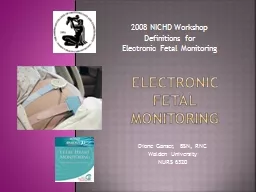

2008 NICHD Workshop Definitions for Electronic Fetal Monitoring Dione Ganser BSN RNC Walden University NURS 6320 objectives Students will be able to Discuss types of monitoring external vs ID: 683016
Download Presentation The PPT/PDF document "Electronic Fetal Monitoring" is the property of its rightful owner. Permission is granted to download and print the materials on this web site for personal, non-commercial use only, and to display it on your personal computer provided you do not modify the materials and that you retain all copyright notices contained in the materials. By downloading content from our website, you accept the terms of this agreement.
Slide1
Electronic FetalMonitoring
2008 NICHD WorkshopDefinitions for Electronic Fetal Monitoring
Dione Ganser, BSN,
RNC
Walden University
NURS
6320Slide2
objectives
Students will be able to -Discuss types of monitoring- external vs.
internal. -Identify baseline FHR.
-Identify FHR variability. -Identify FHR decelerations. -Identify FHR accelerations.
-Understand reason for FHR declerations. -Discuss frequency, duration, and intensity of contractions.
Slide3
History of electronic fetal monitoring
Reference: Lyndon, A. & Ali,
L.U. (2009), Sharma ,
D.L. (2010), Stevenson & Benitz (2003)Slide4
Monitoring contractions
Palpation
External
tocodynamometer
Internal
Intrauterine Pressure CatheterSlide5
Monitoring fetal heart rate
External continuous ultrasound monitors
Internal fetal scalp electrode for continuous fetal heart rate tracing.
External devices for listening to fetus
Early wooden
stethescope
Fetoscope
DopplerSlide6
Electronic Fetal monitors
“Get me outta here!” –Love, BabySlide7
Contractions
1 minute
1 minute
1 minute
1 minute
1 minute
1 minute
Frequency
of contractions are defined as the time in minutes between the start of one contraction and the start of the next.
2 minutes
Duration
is measured in seconds from the start to the end of a contraction.
60 seconds
Intensity
measures the strength of the contraction.
IUPC
is the only quantitative measurement of contractions.
IntensitySlide8
fhr baseline
120
BPM
130
BPM
140
BPM
150
BPM
Baseline FHR is the median rate to the nearest 5
BPM
. A normal FHR baseline is between 110 and 160
BPM
. Below 110
BPM
is
bradycardia
. Above 160 is tachycardia.
The fetal heart rate in the above graph has visually apparent variability between approximately 130 and 140. The middle ground of this variability, to the nearest 5
BPM
, is 135
BPM
.
Median 135
Lyndon & Ali, 2009Slide9
Fhr variability
Absent variability has undetectable amplitude.
Minimal variability has FHR fluctuations between 1-5
BPM
.
Moderate variability has FHR fluctuations between 6-25
BPM
.
Marked variability has FHR fluctuations over 25
BPM
.
V
ariability is the irregular amplitude fluctuations of the FHR. It is considered one of the most important predictors of adequate fetal oxygenation.
NCC
Monograph, 2010Slide10
accelerations
Fetal heart rate accelerations-
Less than 32 weeks- 10 x 10
Greater than 32 weeks- 15 x 15
Acceleration
Prolonged
accleration
Prolonged accelerations last for over 2 minutes but less than 10 minutes.
An acceleration that last for more than 10 minutes is considered a baseline change.
NCC
MonographSlide11
Variable deceleration
Variable decelerations are an
a
brupt drop in fetal heart rate regardless of relationship to contractions
.
This abrupt drop in FHR indicates umbilical cord compression.
NCC
MonographSlide12
Late deceleration
The gradual change of late decelerations indicates utero-placental insufficiency.
Late decelerations usually start after the peak of the contractions. This gradual decrease from baseline to nadir is over 30 seconds or more.
These decelerations only occur with contractions.
Intrauterine resuscitation measures-
-
Maternal repositioning
-Fluid bolus
-Correction of maternal hypotension
-Evaluate and correct for
tachysystole
-Maternal oxygen supplementation by non-
rebreather
mask in the presence of minimal or absent variability.
NCC
MonographSlide13
Early deceleration
The gradual decrease of FHR mirrors the increase and decrease of contractions.
Early decelerations indicate fetal head compression.
NCC
Monograph
Early
EarlySlide14
Prolonged deceleration
Bradycardia
Tachycardia
Pseudosinusoidal
Sinusoidal
Please find more helpful information at :
dmganser2.weebly.comSlide15
references
Fedorka, P. (2010). Electronic fetal monitoring: an update. Journal of Legal Nurse Consulting
, 21(1), 15-18. Retrieved from EBSCO http://
web.ebscohost.com.ezp.waldenulibrary.org/ehost/pdfviewer/pdfviewer?si d=e2f19c0f-c74c-41f2-b5cc-7b4eb9485962%40sessionmgr13&vid
=7&hid=15Lyndon, A. & Ali, L.U. (Eds.) (2009).
Fetal Heart Monitoring: Principles and Practices
(4
th
ed.).
Washington D.C.: Kendall Hunt.
Macones
,
G.A
., Hankins,
G.D.V
.,
Spong
,
C.Y., Hauth
, J., & Moore, T. (2008). The 2008 National Institute of Child Health and Human Development workshop report
on electronic fetal monitoring. Journal of Obstetrics, Gynecologic and Neonatal Nursing, 37(5), 510-515.Murray, S.S. & McKinney,
E.S
. (2010).
Foundations of maternal-newborn and women’s
health nursing (5
th
Ed.).
Maryland Heights, MO: Elsevier.
National Certification Corporation (2010).
NICHD
Definitions and classifications:
Application to electronic fetal monitoring interpretation.
NCC
Monograph,
3(1).Sharma, D.L. (2008). Electronic fetal monitoring [Slideshow]. Retrieved from http://
www.obgyn.net/educational-tutorials/article/12571.Stevenson, D.K. & Benitz, W.E
. (2003). Fetal and neonatal brain injury: Mechanisms, management, and the risks of practices (3rd Ed.). New York, NY: Cambridge
University Press.